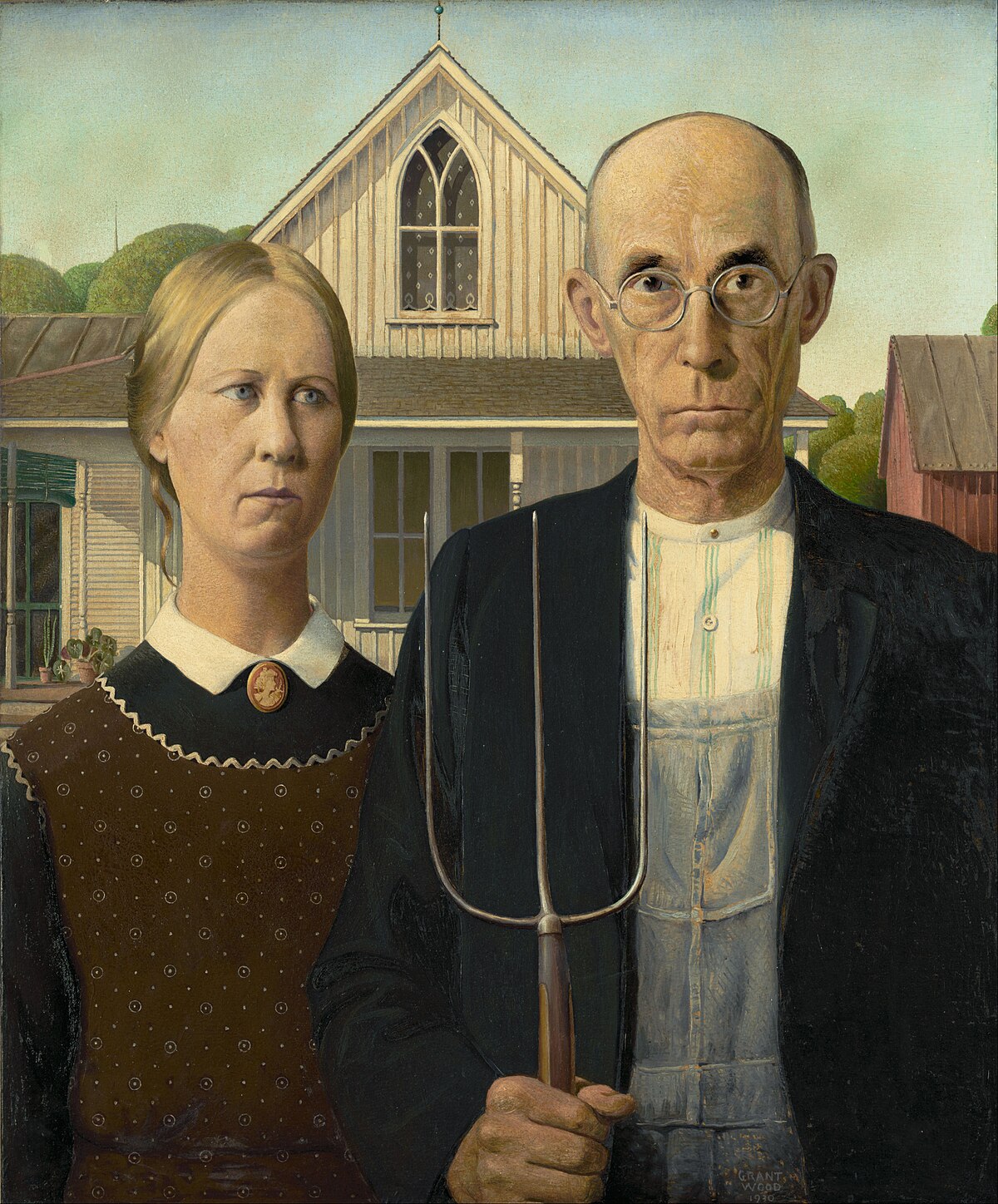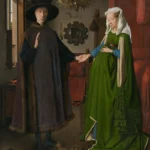
“American Gothic” is one of the most iconic and recognized paintings in American art history. Created by the American artist Grant Wood in 1930, it is a masterpiece of Regionalism, an art movement that celebrated rural life and the American heartland during the early 20th century.
The painting features a stern-looking farmer standing beside his daughter in front of a Gothic-style farmhouse. The man holds a pitchfork, and the woman stands beside him, both with somber expressions. The backdrop of the painting is a simple, rural landscape. The composition is characterized by its detailed and realistic style, reminiscent of Northern Renaissance art.
Grant Wood completed the painting “American Gothic” in 1930, during the early years of the Great Depression in the United States. The timing of its creation is significant, as it reflects the economic challenges and social changes of the era. The painting’s portrayal of a stern, hardworking farmer and his daughter is often seen as a commentary on the resilience and stoicism of rural Americans facing adversity during this time.
“American Gothic” is an oil painting on beaverboard, a type of hardboard often used by artists in the early 20th century. The choice of medium allowed Wood to achieve the fine details and textures present in the work.
The painting is a quintessential example of Regionalism, an American art movement that emerged in the 1930s and celebrated rural life and the American heartland. Grant Wood, along with artists like Thomas Hart Benton and John Steuart Curry, was a leading figure in this movement, and “American Gothic” exemplifies the Regionalist style.
The dimensions of the painting are 74.3 cm × 62.4 cm (29 1/4 in × 24 1/2 in), making it a relatively small artwork. Despite its modest size, it has had an enormous impact on American art and culture.
“American Gothic” depicts a farmer standing beside his daughter in front of a Gothic-style farmhouse. The male figure holds a pitchfork, while the woman stands beside him. Their austere expressions and posture have made them iconic figures in American art.
The painting resides in the collection of the Art Institute of Chicago, where it has been displayed for many years. It is a prominent and highly sought-after piece in the museum’s collection.
The setting of “American Gothic” is based on a real farmhouse in Eldon, Iowa. Grant Wood was inspired by the architecture of the house when he decided to create the work. He sketched the house on a trip to Eldon and later added the farmer and his daughter to the composition.
Grant Wood used individuals from his own life as models for the painting. The farmer figure is based on Wood’s dentist, Dr. Byron McKeeby, and his sister, Nan Wood Graham, posed as the daughter. Wood’s use of real people as models adds a personal touch to the work.
One of the most striking aspects of “American Gothic” is the stern and unsmiling expressions of the farmer and his daughter. Their somber demeanor has led to various interpretations, with some seeing it as a commentary on the seriousness and hardships of rural life during the Great Depression.
In 1930, Grant Wood was awarded a bronze medal for “American Gothic” at the Art Institute of Chicago’s annual exhibition. The recognition helped solidify the painting’s status as an important work of American art and drew attention to Wood as a leading artist of the time.
“American Gothic” has been the subject of numerous parodies and references in popular culture. From advertising campaigns to cartoons, the iconic image of the stern-faced farmer and daughter has been reimagined and satirized in various ways, highlighting its enduring impact on American visual culture.
To ensure the long-term preservation of “American Gothic,” the Art Institute of Chicago has taken meticulous care of the painting. It is displayed in a controlled environment that regulates temperature, humidity, and lighting to protect the artwork from deterioration.
“American Gothic” is not just an artwork; it has become a cultural icon. Its imagery is instantly recognizable to people around the world, making it one of the most celebrated and parodied paintings in history.
The image of “American Gothic” has been widely reproduced and commercially used. It can be found on various products, from postcards and posters to coffee mugs and clothing, further solidifying its place in popular culture.
Interpretations of “American Gothic” have varied over the years. Some view the farmer as representing traditional conservatism, while the daughter symbolizes progress and modernity. The contrast between the two figures sparks discussions about American values and identity.
Grant Wood employed a meticulous and detailed artistic process in creating “American Gothic.” He drew from his training in European Renaissance techniques, including precise brushwork and attention to detail, to capture the fine textures and expressions of the subjects.
The painting’s creation during the Great Depression gives it added historical significance. It reflects the economic challenges of the time and the cultural response to those challenges through art.
When “American Gothic” was first exhibited, it received mixed reviews from critics. Some praised its portrayal of rural life, while others found it overly simplistic. Regardless of the initial reactions, it has since become a revered masterpiece.
The clothing worn by the farmer and daughter in “American Gothic” is noteworthy. The man is dressed in overalls, a symbol of hard work and practicality, while the woman’s attire is conservative and reflects the traditional values often associated with rural America.
The painting was purchased by the Art Institute of Chicago in 1930 for $300. Since then, it has remained in the institute’s collection, and its ownership has not changed hands. The institute’s stewardship has ensured the painting’s continued availability for public viewing.
Grant Wood drew inspiration from Northern Renaissance art, particularly the works of 15th-century Flemish painters like Jan van Eyck. The detailed and precise rendering of the subjects and their environment in “American Gothic” reflects Wood’s admiration for this artistic tradition.
Over the years, “American Gothic” has been subject to various interpretations. Some see it as a straightforward depiction of rural life, while others view it as a commentary on societal changes, the clash between tradition and modernity, or even as a satirical statement on Midwestern values.
The depiction of the farmer and his daughter against the backdrop of a Gothic-style farmhouse has been interpreted as a representation of rural American values. The Gothic architecture of the house may symbolize a connection to European heritage and traditions.
“American Gothic” is not limited to American recognition alone; it enjoys global fame. Its distinctive imagery has made it an instantly recognizable symbol of American art worldwide.
Grant Wood’s “American Gothic” has had a profound influence on American art. It helped establish Wood as a leading figure in American Regionalism, influencing other artists who explored similar themes of rural life, community, and identity in their work.
Frequently Asked Questions about the American Gothic:
- Who are the people depicted in American Gothic?
The seemingly stern-faced couple in American Gothic are not actually a farmer and his wife, as some might assume. Grant Wood, the artist, used his dentist’s daughter, Nan Wood Graham, as the model for the woman. For the man, he used a local farmer named Charles Rosenfeldt, but Wood posed him in overalls he found hanging in his father’s barn for a more rugged appearance.
- What is the meaning behind American Gothic?
The meaning of American Gothic has been debated and interpreted in various ways since its creation. Grant Wood himself offered somewhat ambiguous statements. Here are some potential interpretations:
- Homage to the American Midwesterner: The painting could be seen as a tribute to the resilience and stoicism of the American farming community in the Midwest during the early 20th century. The couple’s upright posture and determined expressions might reflect these qualities.
- Satire of Rural Life: Another perspective views the painting as a satirical commentary on the potentially harsh realities and limitations of rural life. The couple’s seemingly rigid and dour expressions could represent this viewpoint.
- Open to Interpretation: Wood’s lack of a definitive explanation allows viewers to bring their own experiences and perspectives to the painting, creating a richer and more personal experience.
- Why is the house in the background so unique?
The house featured prominently behind the couple is a Carpenter Gothic style home, characterized by pointed arches, steep rooflines, and decorative trim. This architectural style was popular in the mid-19th century but was considered somewhat outdated by the time Wood painted American Gothic in 1930. Including this house might further emphasize the painting’s connection to a specific time and place in American history.
- How famous is American Gothic and where is it located?
American Gothic is one of the most recognizable paintings in American art. Its simple composition, stark subject matter, and open-ended meaning have captured the public’s imagination for decades. The painting is parodied and referenced frequently in popular culture. The original artwork is part of the permanent collection at the Art Institute of Chicago.
- Can I visit the house depicted in the painting?
Yes! The house featured in American Gothic is located in Eldon, Iowa, and is now a museum dedicated to the painting and Grant Wood’s work. Visitors can tour the house, learn more about the painting’s history and interpretations, and see other exhibits related to Wood and American art.










Right here is the right web site for anybody who wishes to find out about this
topic. You know so much its almost hard to argue with you (not that I
actually will need to…HaHa). You certainly put a new spin on a topic that’s been written about for years.
Excellent stuff, just great!